Serving 924 students in grades Kindergarten-8, Denver Language School ranks in the top 10% of all schools in Colorado for overall test scores (math proficiency is top 5%, and reading proficiency is top 5%).
The percentage of students achieving proficiency in math is 63% (which is higher than the Colorado state average of 32%). The percentage of students achieving proficiency in reading/language arts is 62% (which is higher than the Colorado state average of 45%).
The student:teacher ratio of 16:1 is higher than the Colorado state level of 15:1.
Minority enrollment is 58% of the student body (majority Hispanic), which is higher than the Colorado state average of 50% (majority Hispanic).
Quick Stats (2025)
- School Type: Charter School
- Grades: Kindergarten-8
- Enrollment: 924 students
- Student:Teacher Ratio: 16:1
- Minority Enrollment: 58%
- Overall Testing Rank: Top 10% in CO
- Math Proficiency: 63% (Top 5%)
- Reading Proficiency: 62% (Top 20%)
- Science Proficiency: 30-39% (Top 50%)
- Source: National Center for Education Statistics (NCES), CO Dept. of Education
Top Rankings
Denver Language School ranks among the top 20% of public schools in Colorado for:
Category
Attribute
Overall Rank
Math Proficiency
Reading/Language Arts Proficiency
Diversity
School Overview
Denver Language School's student population of 924 students has grown by 12% over five school years.
The teacher population of 58 teachers has grown by 20% over five school years.
School Type
Grades Offered
Grades Kindergarten-8
Total Students
924 students
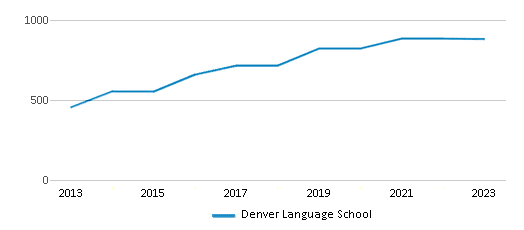
Gender %
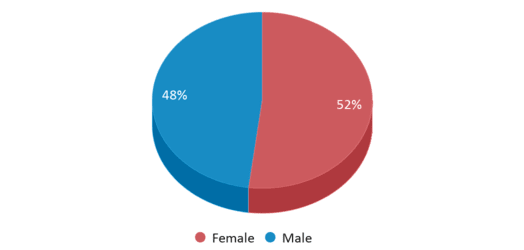
Total Classroom Teachers
58 teachers
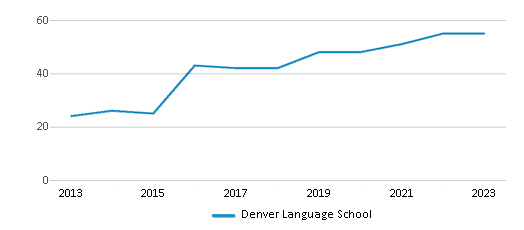
Students by Grade
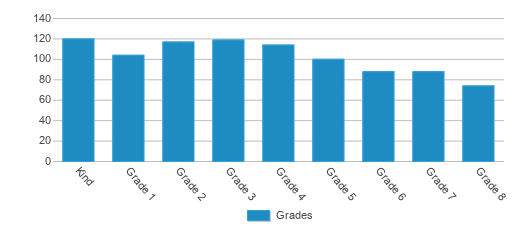
School Calendar
School Rankings
Denver Language School ranks within the top 10% of all 1,779 schools in Colorado (based off of combined math and reading proficiency testing data).
The diversity score of Denver Language School is 0.71, which is more than the diversity score at state average of 0.62. The school's diversity has stayed relatively flat over five school years.
Overall Testing Rank
#174 out of 1779 schools
(Top 10%)
(Top 10%)
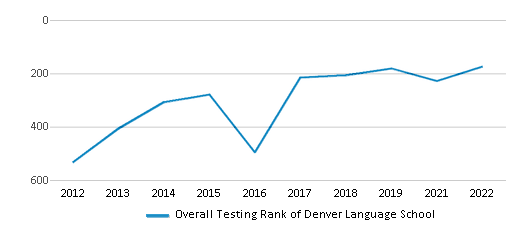
Math Test Scores (% Proficient)
63%
32%
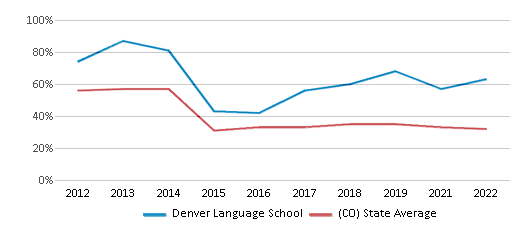
Reading/Language Arts Test Scores (% Proficient)
62%
45%
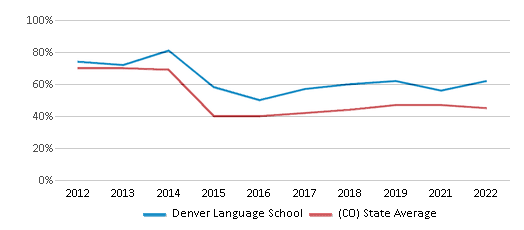
Science Test Scores (% Proficient)
(20-21)30-39%
29%
Student : Teacher Ratio
16:1
15:1
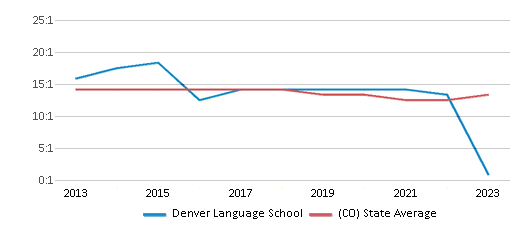
American Indian
n/a
1%
Asian
6%
3%
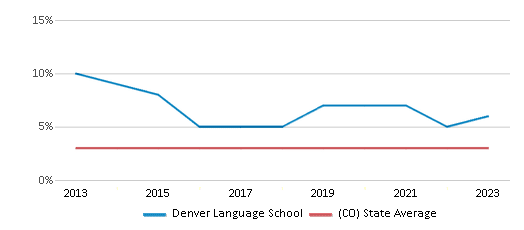
Hispanic
30%
36%

Black
5%
5%
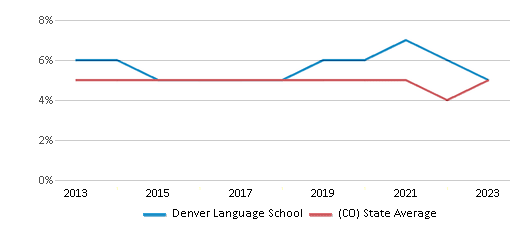
White
42%
50%
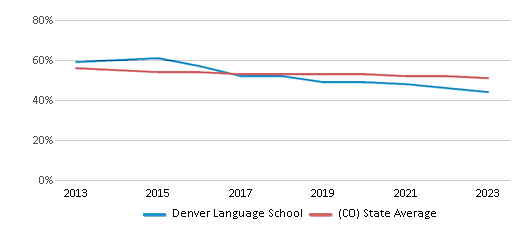
Hawaiian
n/a
n/a
Two or more races
17%
5%
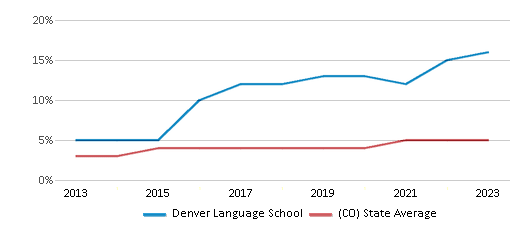
All Ethnic Groups
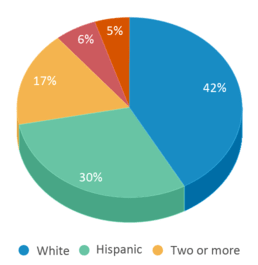
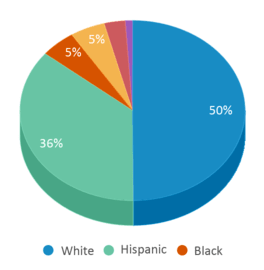
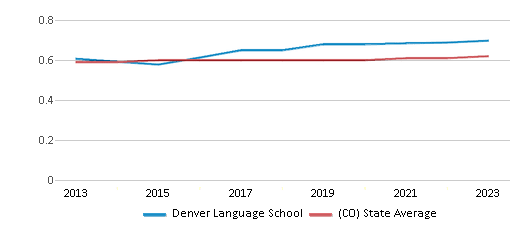
Eligible for Free Lunch
17%
39%

Eligible for Reduced Lunch
4%
6%
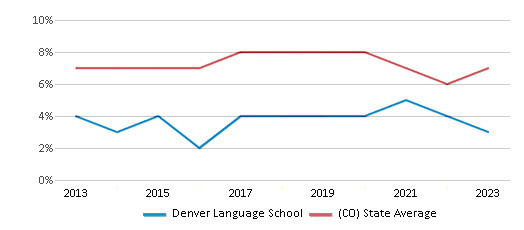
School Statewide Testing
School District Name
Source: National Center for Education Statistics (NCES), CO Dept. of Education
Profile last updated: 02/09/2025
Frequently Asked Questions
What is Denver Language School's ranking?
Denver Language School is ranked #174 out of 1,779 schools, which ranks it among the top 10% of public schools in Colorado.
What percent of students have achieved state testing proficiency in math and reading?
63% of students have achieved math proficiency (compared to the 32% CO state average), while 62% of students have achieved reading proficiency (compared to the 45% CO state average).
How many students attend Denver Language School?
924 students attend Denver Language School.
What is the racial composition of the student body?
42% of Denver Language School students are White, 30% of students are Hispanic, 17% of students are Two or more races, 6% of students are Asian, and 5% of students are Black.
What is the student:teacher ratio of Denver Language School?
Denver Language School has a student ration of 16:1, which is higher than the Colorado state average of 15:1.
What grades does Denver Language School offer ?
Denver Language School offers enrollment in grades Kindergarten-8
What school district is Denver Language School part of?
Denver Language School is part of School District No. 1 In The County Of Denver And State Of C.
In what neighborhood is Denver Language School located?
Denver Language School is located in the East neighborhood of Denver, CO. There are 18 other public schools located in East.
School Reviews
4 4/7/2017
DLS has been a fantastic school for my children. They've flourished and acquired language skills in their target language without sacrificing English literacy. While they have a middle school program, a majority of families do leave for other schools after fifth grade. I believe that this is due to several factors including not having a large enough facility to house K-8 comfortably. They are well aware that this is an issue for parents and are actively seeking a permanent solution. Unfortunately, this might be a long game. Also, since most families leave, class sizes in the middle school are tiny, which limits social opportunities. Another issue is not having a robust enough middle school program. Parents want STEAM and they want their kids to be challenged in those disciplines. Families are in the unfortunate position of having to choose between a more academically diverse education and language immersion. Middle schools in the area can only offer a world language class twice a week at best, which means that many DLS students will be losing the language skills that they worked so hard to acquire. We haven't decided what we will do when we reach the middle school years just yet, but it's heavy on our minds.
Review Denver Language School. Reviews should be a few sentences in length. Please include any comments on:
- Quality of academic programs, teachers, and facilities
- Availability of music, art, sports and other extracurricular activities
Recent Articles
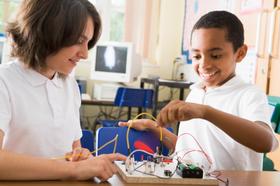
What Is A Charter School?
Explore the world of charter schools in this comprehensive guide. Learn about their history, how they operate, and the pros and cons of this educational innovation. Discover key facts about charter schools, including admission policies, demographics, and funding, as well as what to look for when considering a charter school for your child.

10 Reasons Why High School Sports Benefit Students
Discover the 10 compelling reasons why high school sports are beneficial for students. This comprehensive article explores how athletics enhance academic performance, foster personal growth, and develop crucial life skills. From improved fitness and time management to leadership development and community representation, learn why participating in high school sports can be a game-changer for students' overall success and well-being.

February 05, 2025
Understanding the U.S. Department of Education: Structure, Impact, and EvolutionWe explore how the Department of Education shapes American education, from its cabinet-level leadership to its impact on millions of students, written for general audiences seeking clarity on this vital institution.









